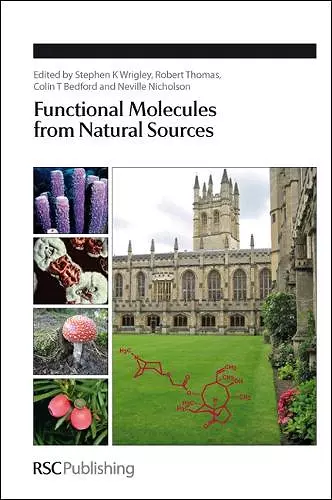Functional Molecules from Natural Sources
Robert Thomas editor Stephen K Wrigley editor Neville Nicholson editor Colin Bedford editor
Format:Hardback
Publisher:Royal Society of Chemistry
Published:26th Nov '10
Currently unavailable, and unfortunately no date known when it will be back

-Contains up-to-date, well-referenced perspectives in the use of natural products and their derivatives -Summarizes new approaches to optimising the exploitation of naturally occurring compounds -Represents a unique blend of industrial and academic perspectives -Provides examples of successful and potentially useful natural products and recently discovered novel biologically active compounds
This book is based on the proceedings of the conference, Functional Molecules from Natural Sources, held at Magdalen College, Oxford, in July 2009.
Naturally occurring compounds, or natural products, have been and continue to be an important source of commercially successful products and leads in the pharmaceutical, agrochemical and nutritional sectors. The conference Functional Molecules from Natural Sources, which was held at Magdalen College, Oxford in July 2009, set out to highlight current trends, challenges and successes in the exploitation of natural products from microbial, plant and marine sources. This book is based on the proceedings of the conference and comprises modern and emerging perspectives on natural product utilization and improved strategies for their exploitation. Several case studies on important natural product leads, or functional molecules, are presented with the strategy for their development. These detail new medical applications in the use of familiar natural molecules and advances in the understanding and manipulation of natural product biosynthesis at the genetic level. Highlights include an authoritative review of the entire field of natural anticancer agents emphasising those currently in clinical development, an account of the optimisation of the pleuromutilin antibiotic template for human use and a comprehensive description of the research programme that resulted in the discovery of platensimycin. Articles on biosynthesis include studies of the antibiotics of Streptomyces coelicolor A3(2), the anthrax siderophore petrobactin and the modification of oxidation and glycosylation events in the biosynthesis of mithramycins. Written by leading industrial and academic practitioners from each sector, the book offers authoritative updates on new approaches to the use of naturally occurring compounds within the pharmaceutical, nutraceutical and agrochemical industries.
This book is based upon the proceedings of a conference, Functional Molecules from Natural Sources, organised by the Royal Society of Chemistry’s Biotechnology Group and held at Magdalen College, Oxford, in July 2009. Most of the eighteen chapters are in the form of a transcript of an individual lecture given at the conference, while others are derived from a selection of the posters presented at it, and the final chapter provides a summary of those lectures for which a transcript was not available. In order to gain most benefit from the book, readers require some prior knowledge of medicinal or pharmaceutical chemistry and, consequently, its usefulness to many chemistry undergraduate students is likely to be limited. Moreover, at £109.99, it is priced well beyond that which most undergraduates would be willing to spend. As is to be expected from any book where individual chapters are written by different authors, the style of the writing varies considerably from chapter to chapter. In some of the best chapters the original `transcript’ appears to have been re-written by its author to make it a more readable chapter in the book. The book concentrates on the continuing importance of active compounds originally identified in and isolated from microbial, plant, and marine sources. The first chapter consists of a comprehensive survey of anticancer compounds that are currently undergoing clinical trials. This is followed by chapters that are case studies of the identification of functional compounds, their subsequent development and enhancement. While later chapters deal with the biosynthesis and genetics of active compounds. Altogether there is much to interest those working in drug discovery and development, or related fields. For undergraduate students, and their teachers, probably the two most useful chapters are “Discovery and Development of Antibiotics with Novel Modes of Action” (S B Singh), an interesting and elegantly written account of the discovery of platensimycin for development as a new antibiotic, and “High Capacity Countercurrent Chromatography for Fast Isolation of Natural Products” (I J Gerrard and D Fisher), a concise account of an important technique that is unlikely to be encountered in standard undergraduate chemistry textbooks. The book contains few errors, and these are simply printing mistakes. However, in some of the cases where the skeletal formula of a compound is included in the text it is on a different page to that in which the compound is first introduced, thus necessitating superfluous page turning and sometimes making it more difficult to compare molecular structures, while in others the size in which the formula has been printed is so small (e.g. page 63, figure 11) as to make comparison of structures hard work. Other figures too, including some photographs of cultures from a microbial strain collection (page 85, figure 2) have been printed too small to serve any useful purpose. The use of colour in the three dimensional molecular diagrams, especially where this had clearly been intended (e.g. page 179, figure 22), would also have been helpful. Although such flaws are not uncommon in contemporary chemistry texts, it would have made the reading of this book a more comfortable experience if they had been rectified prior to publication. It is possible that increasing the number of pages to accommodate larger figures or enable their position in the text to be changed, and the use of colour for diagrams, were rejected on grounds of cost. But if that is the case, a more appropriate economy would have been to publish the book as a paperback rather than a hardback. -- Julian Perfect - New York University in London * Higher Phys Ed Sci Acad Cen - Journal 22 Vol 12 Issue 1 *
ISBN: 9781847552594
Dimensions: 234mm x 156mm x 14mm
Weight: 520g
244 pages